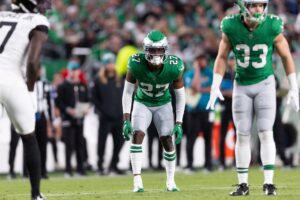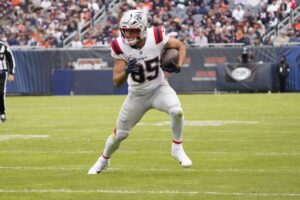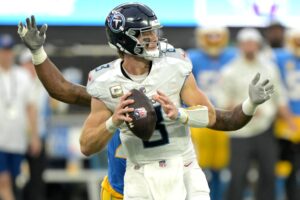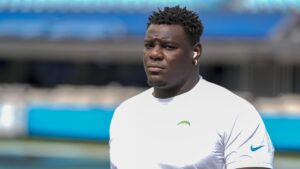Martyball is dead, long live Brianball. Ok, it doesn’t have the same ring to it and it’s not really a thing at all, but we’ll gloss over that. Brian Schottenheimer began coaching with the Rams (of St. Louis in those days) in 1997 and moved on to the Chiefs staff in 1998 where the head coach was some guy called Marty. Kansas City ended that season 7-9, many blamed the team’s conservative style of play (aka Martyball) and Marty resigned. There was another familiar face on that Chiefs coaching staff, Mike McCarthy. So that’s how that happened.
Brian Schottenheimer’s Dallas Cowboys From Hell
25 Years
Fast forward 25 years and the dynamic duo are reuniting in Dallas. Who calls the plays for the Cowboys offense is a bit of a mystery, it might be McCarthy, but if it is why did they fire Kellen Moore? Assuming that the Cowboys’ 2022 offense was actually Moore’s how can we expect it to change with Schottenheimer pulling the strings?
Brian has been an offensive coordinator since 2006 when he was in charge of Chad Pennington’s New York Jets who finished 10-6 that season. That team threw the ball on 48% of their snaps, which isn’t entirely relevant since the NFL has changed drastically in the intervening 17 years. But that Jets team did have their own version of Tony Pollard in Leon Washington with Laveraneus Coles and Jerricho Cotchery playing the roles of Michael Gallup and CeeDee Lamb. That Jets team only threw to their tight ends 54 times (told you things had changed a bit).
Revolution Is My Name
More recently Schottenheimer was the brains behind the Seahawks offense between 2018 and 2020. The Seahawks finished second in the NFC West and won it during Schottenheimer’s tenure. So, three playoff runs in three seasons. Not too shabby. During his first season, they were 10th in the NFL in terms of points scored, fifth for passing touchdowns, and they had the lowest number of turnovers in the league. That’s why McCarthy has brought him to Dallas.
Domination
In the 2018 regular season, Schottenheimer’s Seahawks only passed the ball 42% of the time (some wag once said the major principle of Martyball was to call a rushing play on first down and then on second down call another rushing play. They were only half joking). The Seahawks 427 regular season pass attempts ranked them dead last. Their 534 running plays ranked second and was one of the reasons they lead the league in rushing yards. The other two reasons were Chris Carson, who had an outstanding year, running for 1,151 yards (and catching 20 passes). And Mike Davis, who ran for 514 yards (and racked up 24 receiving yards too). With no Ezekiel Elliott, the only Cowboys running back who is comparable to Carson and Davis is Ronald Jones II. Jones has only started three games in the last two seasons though.
Death Rattle
The following season Schottenheimer’s offense ranked fourth for rushing yards and third for rushing attempts as they passed on 49.4% of their downs. In 2019, no quarterback took more sacks in the regular season than Russell Wilson though, he hit the deck 48 times. But he also led the league in fourth-quarter comebacks and game-winning drives, so despite the dodgy pass blocking it wasn’t a completely disastrous campaign.
13 Steps To Nowhere
Schottenheimer’s final season in Seattle saw the Seahawks end with a 12-4 record and win the division. Some (well, Richard Sherman, probably) would say the success was down to the defense. The defense did create 22 turnovers and rank ninth for the number of touchdowns they allowed. But Wilson threw 40 touchdown passes and the offense was ranked eighth in the league for points scored. But as they took the handcuffs off Wilson the turnovers went up too. They were ranked 17th for the number of interceptions they threw and 10th overall for total turnovers.
The Seahawks had some pretty banged-up running backs in 2020 too. Carson carried for 681 yards at 4.8 yards per carry but only played 12 games. Three other backs started games, Deejay Dallas, Carlos Hyde, and Alex Collins, all took a turn. Bo Scarborough, Rashaad Penny, and Travis Homer all featured, too. But only Carson carried for more yards than Russell Wilson did. Using Prescott’s legs as well as his arm might be the key to Schottenheimer’s Cowboys offense.
Strength Beyond Strength
Dak Prescott has become a victim of his own success. In his first year as a starter, he ended the season with 13 wins, a feat he’s never matched. That season the Cowboys passed the ball 48% of the time, the 30th most in the league. Elliott ran for 1,631 yards at 5.1 per carry and caught 32 passes ending the season with 1,994 yards from scrimmage. Prescott himself ran for six touchdowns and averaged 4.6 yards per carry. Cole Beasley was the leading receiver and he only started six games. Jason Witten and Prescott were the only two skill players who started all 16 games in 2016. Prescott’s 2016 success really came in the face of some pretty serious adversity.
All of Prescott’s successful seasons (he’s had five winning campaigns in total) have involved a balanced offense. 2021 was the most pass-heavy season (56%), the Cowboys won the NFC East as Prescott threw 37 touchdowns. That was also his most accurate passing season so far, he ended the season with a 68.8% completion rate and his 1.7% interception rate was his lowest since 2018. Interceptions were a big problem last season, but Prescott battled injuries for long periods and the issue seems more of an anomaly than a trend.
Two of Prescott’s most successful seasons have coincided with him throwing for fewer air yards too. In 2018 his completed passes traveled 5.6 yards in the air, the fewest of his career since records began. In 2019, it was 5.9 yards. He’s also been successful throwing play-action passes, in 2019 he threw 129 play-action passes for 1,219 yards and in 2021 he threw 118 passes for 953 yards.
Walk
Here’s where it gets a bit tricky to discern any particular patterns. In 2018, the Cowboys’ leading receivers were Elliott and Beasley. In 2019 and 2020, it was Amari Cooper and Michael Gallup. And in 2021 CeeDee Lamb and Dalton Schultz. Only two of those players remain in Dallas.
Based on the first seven years of his career the problem isn’t the system, any system, it’s Prescott’s own inconsistency. That has been exposed and only exasperated by the revolving door of players on the ever-changing roster around him (Ezekiel Elliott and Dalton Schultz both left this offseason).
It Makes Them Disappear
There’s no reason Schottenheimer and Prescott shouldn’t be able to find a successful game plan between them (establish the run, get him moving outside the pocket, and throw short, play-action passes should do it). Of course, that requires a versatile offensive line. Big guys who can run block as well as they pass block can be hard to find. If Schottenheimer and Prescott can’t reproduce the Seahawks 2018 season, the finger should be pointed at the people in charge of retaining the talent not the people in charge of the playbook.
Main Image: Jasen Vinlove-USA TODAY Sports






